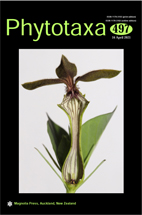Abstract
A natural hybrid between Goyazia and Mandirola (Gloxiniinae, Gesneriaceae) from Cerrado (Brazil) is here described, supported by pollen morphology, cytological data and morphological characters. The microsporogenesis of Mandirola hirsuta and that of the hybrid were analyzed in order to evaluate the cytogenetic characteristics. The haploid chromosome numbers observed were n = 12 for M. hirsuta and n = 11, 13, 16 and 26 for the hybrid. Structural abnormalities (monads, dyads, triads and micronuclei) were observed at the final of the hybrid’s meiosis. High viability rates of the pollen were recorded for Goyazia and Mandirola (>90%) and low viability for the hybrid (34.7%). The pollen grains were acetolyzed, measured and photographed for pollen morphology analysis. Quantitative pollen data were analyzed through descriptive and multivariate statistics. The hybrid has intermediate pollen characteristics between G. petraea and M. hirsuta; it is more related to G. petraea by the measures of diameters and ectoapertures; it is more similar to M. hirsuta mainly regarding the microreticulum on the mesocolpium region. The hybrid and Mandirola share vegetative and flower size, while the colors of the hybrid are similar to Goyazia. Pollen morphology, cytological data and morphological characters brought clear evidence for the recognition of the intergeneric hybrid, which we named as Goydirola x punctata.

